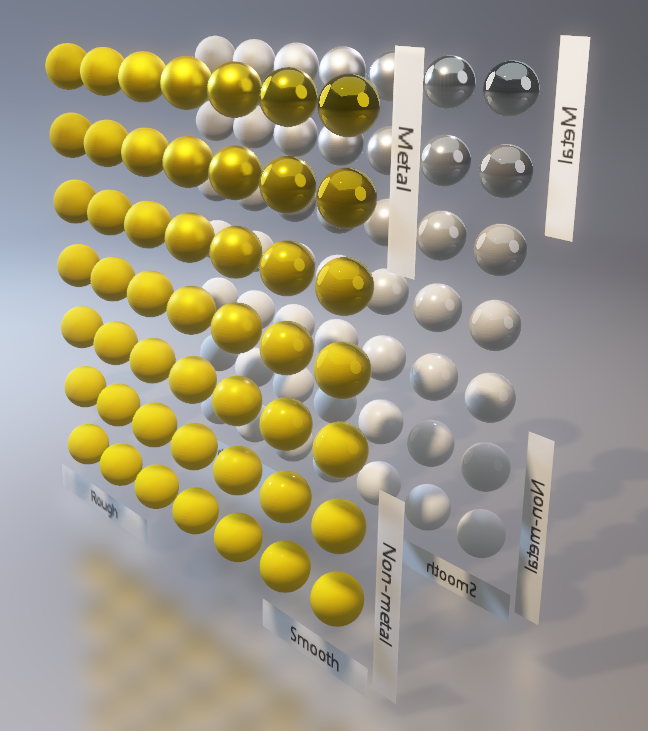About Monkey 2 › Forums › Monkey 2 Development › Metal Rough Spheres example
This topic contains 6 replies, has 3 voices, and was last updated by ![]() Hezkore
Hezkore 1 year, 9 months ago.
1 year, 9 months ago.
-
AuthorPosts
-
July 5, 2017 at 7:37 pm #9141
Are the PBR metal spheres supposed to look like this?


If I load them in Windows 10’s app, they look like this:

I’m on Windows 10 using an ATI R9 390x
July 6, 2017 at 5:52 am #9149I get the first 2 versions on macOS – that last one looks lush.
Seems we have our first nasty bug!
July 6, 2017 at 11:42 pm #9152Can you post more info? OS, graphics card etc, anything that could be useful.
If I load them in Windows 10’s app, they look like this:
What app do you mean?
July 6, 2017 at 11:47 pm #9153Well as I said, I’m on Windows 10 using an ATI R9 390x GPU.
The Windows 10 app is called “View 3D” and comes with the newer Windows 10 versions.Mark if you jump into the IRC monkey2 room, we can have a direct chat and debug this if you want.
I’ll test any code you throw at me.
The new Ted2Go version has IRC built into it, or you could just use a web client.
We’re at Freenode #monkey2I’m doing some of my own mesh loading and I’m noticing a lot of problems with the 3D engine as I go along.
I think it may be the shadows actually.
 July 7, 2017 at 12:01 am #9154
July 7, 2017 at 12:01 am #9154Can’t spend any time on this right now, just collecting info…
It looks like a shadows issue to me, but there’s currently no way to turn them off. Also, the shadow technique used is designed for large scale outdoors scenes and will not work too well indoors (but it should still work…).
A lot of the flickering on the indoor scene is likely to be due to the fact the light is pointing straight down so is ‘grazing’ the vertically oriented walls which is resulting in numerical ‘epsilon’ problems. Try rotating the light a little bit! There are various fudge factors that can help with these problems, but I haven’t explored them much. I will make them easier to play with in the next release.
There is still a LOT of work to do so don’t expect too much at this point. It all works well on *my* machines, but there is a lot of different 3d hardware around and it wont work the same on everyone’s. My guess would be your depth textures have a lower precision than mine, which, if true, means you *will* get lower quality shadows, but of course things shouldn’t flicker like crazy.
Quick idea: you can disable shadows for now by changing ‘float shadow=evalShadow();’ to ‘float shadow=1.0;’ in modules/mojo3d/graphics/shaders/directional-light.glsl. Can you try this and post another screenshot, preferably from above, looking down on the scene? Since light is pointing down (and there’s no global illumination!) an ‘underneath’ shot is only showing ambient lighting.
July 7, 2017 at 12:15 am #9155Also, any chance you can send me the (quake?) mesh you’re using?
July 7, 2017 at 12:20 am #9156Weird, this is a pretty high end GPU, and I’m sadly having the same flickering on my other machines. :/
But the flickering is gone with shadows disabled.This isn’t just a mesh, it’s my own BSP loader I’m working on.
It directly loads the BSP files from Quake 1, complete with textures and entity information (Textures not applied yet heh)
Something assimp can’t do.Here’s a link to it anyways (Win): https://www.dropbox.com/s/blvpg0746orcsca/m2_bsp_win.7z?dl=0
WASD to move around, arrow keys to look around and Space and CTRL (or just C) to ascend and descend.I just got this working, so it may just be that my normals are way off.
But still, the spheres at my original post is also messed up. -
AuthorPosts
You must be logged in to reply to this topic.